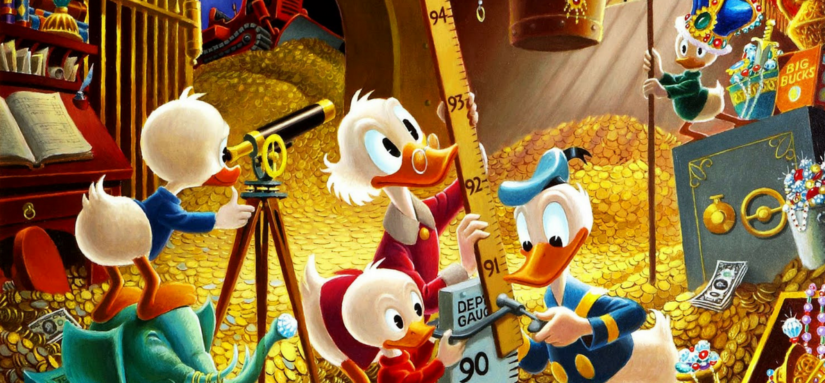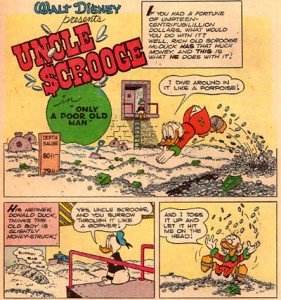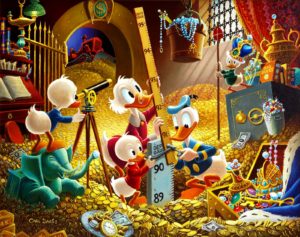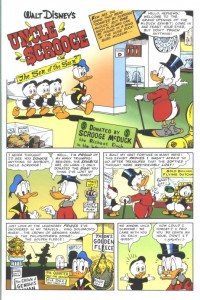All this month, we’ll be helping Children’s Hospital Los Angeles‘ Make March Matter campaign, which aims to raise over a million dollars in March alone for CHLA through the efforts of its corporate partners, among which we are proud to be numbered. Children’s Hospital Los Angeles sees over 528,000 patient visits annually, and is the top ranked pediatric hospital in California by US News & World Report. You can help Make March Matter by simply attending one of the many events or participating in one of the many initiatives being offered by CHLA’s partners (including our event on Saturday, March 17), all listed at www.makemarchmatter.org.
To help remind us all to Make March Matter to support children’s health, we’ll be focusing on kids’ comics and childhood favorites, because we firmly believe that escaping into literature is just as important in keeping children healthy and happy.
Back in the 1930s, Walt Disney was quick to move his characters into the then wildly popular medium of newspaper strips, with Mickey Mouse receiving his own strip in 1930, and Donald Duck following suit in 1938. As comic books began gaining popularity in the late ’30s, Disney, never one to miss out on a promotional opportunity licensed the comic-book rights to his characters to Western Publishing, who first reprinted the newspaper material in Dell Comics’ FOUR COLOR in 1940, which generally printed a variety of newspaper strip in the new comic-book format. When the Disney features in FOUR COLOR met with overwhelmingly positive response, Western debuted in October of that same year WALT DISNEY’S COMICS AND STORIES, and not long after followed that up with solo magazines for MICKEY MOUSE and DONALD DUCK.
If you want to talk about Disney comic books, there’s only one name you really need to know, and that’s the man for years known to Disney comics fans only as “The Good Duck Artist” (since all the work in the Disney comics were uncredited): Carl Barks.
Barks labored for years in anonymity working for Dell Comics on the publisher’s line of Walt Disney Comics, not only writing and drawing dozens of pages per month for decades, but also creating many of the familiar Disney characters like Uncle Scrooge, the Beagle Boys, Gladstone Gander, Gyro Gearloose and many more. Barks had started his career at the Disney animation studio in the 1930s, but health problems forced him to relocate to the desert, where he discovered his true calling, writing and drawing the wildly popular Disney comics, which for many years sold in equal or greater numbers to top industry sellers like Superman and Captain Marvel.
Barks first found success on the DONALD DUCK series, which was where he introduced Scrooge McDuck, Donald’s hyper-fantasticatillionaire uncle, an industrialist tycoon who earned every cent of his millions, refused to part with a nickel of it, and was constantly dragging Donald and his nephews on globetrotting adventures to either protect his fortune or expand it. While the scripts in these comics were first-rate (Barks excelled at both physical comedy and high adventure), with Donald having much more of a personality here than he ever did in the cartoons, the art was absolutely marvelous.
Aside from the gorgeous backgrounds and authentic details (Barks would painstakingly research all of the exotic locales he would send the ducks to, despite having never left California for most of his life), Barks’ true gift as a comic-book artist was the ability to so convincingly wring emotions from his ducks, creating characterizations deeper and more keenly felt than anything found in more “grown-up” comics of the time.
Barks retired in the early 1970s, and it was only in his retirement that he finally received any recognition for his work, as determined fans, now grown, learned his identity and tracked him down, In his twilight years, Barks earned the well-deserved financial success that had elude him for most of his life, producing oil paintings and of his duck characters that would bring big money in galleries nationwide.
Barks passed away in 2000 at the age of 99. Thankfully, his work is now once again available to an American audience with Fantagraphics’s new DONALD DUCK and UNCLE SCROOGE hardcover collections, which offer a steady diet of Barks reprints.
If there’s anyone who’s a modern inheritor of Barks’ throne, it’s Kentucky-born writer/artist Don Rosa, a lifelong fan of Barks’ UNCLE SCROOGE comics, who painstakingly crafted masterful sequels to many of Barks’ classic Scrooge tales, as well as filling in the gaps from Barks’ many stories of Scrooge’s younger days in his critically acclaimed 12-part series THE LIFE AND TIMES OF SCROOGE MCDUCK. Rosa’s work is sharply written and beautifully drawn, with a sparkling wit (and a charming tendency to sprinkle the panels with cute little animals peeking out of the books and crannies).
Ironically, although Rosa is acclaimed throughout Europe (where Disney comics have remained steadily in print and quite popular) as a top talent and masterful storyteller, he remains all but unknown here in his home country, where for many years Disney comics were all but unavailable, due to Disney’s difficulties with earlier licensees such as Gladstone and their own failed attempt to start their own comics imprint. Thankfully, the aforementioned Fantagraphics is showing Rosa’s work the respect it deserves, putting his work together in handsome hardcover collections.






Comments are closed.